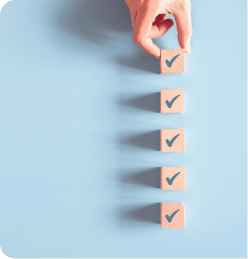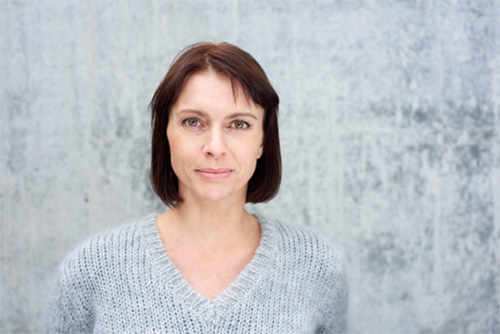Embarking on a journey of change, whether it’s related to your health, well-being, or any aspect of your life, can be a challenging and deeply personal endeavor. Change is not always easy, and it often tests our commitment and resilience. One way to help make making a lifestyle change a little easier is to understand the process of change.

I recently worked with a client Jill in this area. I am sharing parts of her journey (with permission) to illustrate how these stages of lifestyle change come into play. And how you can successfully move through them with a little more ease. To empower you to create a healthier lifestyle and get lasting results, I am also sharing a framework you can use to help you navigate your path to personal growth with more awareness and confidence.
Jill’s story of change
Jill, a 43-year-old busy working mom of 9-year-old twins, was an avid competitive skier. But she hadn’t been exercising regularly outside of her weekend ski hobby since becoming a mom. For years, Jill was so busy focusing on balancing her successful career with being a great parent that she didn’t realize she was on the trajectory to less than optimal health.
At an annual checkup visit, Jill’s doctor pointed out that she had put on a few extra pounds over the last several years. And her cholesterol numbers were slightly elevated. Jill wanted to feel stronger so she could continue her success with skiing. She knew she needed to incorporate regular exercise into her lifestyle, but wasn’t quite sure how. Hearing her doctor tell her that her weight and her cholesterol were up, coupled with the concern of not being strong enough to be as successful as she was with the sport she loved, got her thinking about making a change.
When Jill and I started working together, she told me that although she wanted to be stronger and knew she should be working out more consistently. She simply didn’t have enough time. She was working full-time and extremely successful at her job. But, she said, her most important role was to be the best mom she could be. She simply wasn’t willing to take time away from parenting to exercise. The challenge to balance work, parenting and self care is real. And this internal struggle was causing a kind of mental tug-of-war for Jill.
So to help move her through the mental process of change so she could achieve real and lasting results, we worked together to create a picture of what life would look like if she was working out consistently and back to a healthy weight. She thought about how this change would impact her family, her work, her hobbies, her mood and energy levels. She envisioned spending more time being active with her kids and creating lasting memories with them. Then she considered what life would look like if she stayed on this trajectory and didn’t make a change. Considering the pros and cons of making a change helped Jill see how important her goal really was to her. The consequences of staying stuck weighed more heavily on her than the challenge of changing.
We began by taking a look at Jill’s schedule and identifying all the potential obstacles that could get in the way of making the lifestyle change to exercise more. Then she started gathering some information to make practical preparations for the change ahead.
Although at one point in her life, Jill had a gym membership, at this stage in her life, she said, there was no way she was going to go to a gym. She recognized that she did have a little time in the mornings before the kids were up for breakfast. So she thought that she might be able to squeeze in a 15-minute workout at home. Her first goal was to simply do some research. She set out to find a 15-minute workout video on a streaming service that seemed “doable” for her.
Once she found a video and the time to do it, she looked at her family’s schedule. She identified two mornings and one afternoon that would work for her. She felt fairly confident about putting her plan into action
By setting a clear and achievable goal with small steps and considering her obstacles (time, her children’s needs) and her level of confidence, Jill was setting herself up for success. If Jill had been thinking she needed to work out for an hour a day at a gym, she would likely have felt defeated. She might have moved right back to a state of inaction. But by thinking like Goldilocks and setting a goal that was “just right” and met her where she was, she was ready to take action towards her goal.
After the first week, I had Jill reflect on her success. She realized that did something she previously thought wasn’t possible. What a great feeling! The workout was harder than she thought. But by the third session she felt like she was getting the hang of it. She repeated the process of looking at her schedule and picking three days to exercise. She told her family what she was doing and put her workouts on the family calendar so they wouldn’t interrupt her.
After a few weeks, Jill realized that mornings really did work better for her. She was getting used to waking up earlier, and found she was even waking up before the alarm clock most days! She was able to do a 15-minute workout 5 mornings a week fairly consistently and was feeling great!
Her self-efficacy was improving. She was starting to believe in her ability to take action towards her goal. This feeling of empowerment and possibility provided a source of motivation she didn’t have before. After a few weeks, Jill told me she thought she was ready to try the Level 2 workouts in the series.
Then, life happened. Jill had a series of work trips coming up, which would disrupt her morning schedule. She had to back up and spend some time thinking about how she would handle this obstacle. Jill again weighed the pros and cons of working out on her trip, a little more quickly this time. She decided that sticking to her routine would be better than backsliding into her old patterns. She got right to work on a plan. Since she would be bringing her laptop, she could do the workout in her hotel room before her breakfast meetings. She would need to bring a yoga mat, but that could fit in her suitcase. Jill was ready to take action.
Jill followed through on her workouts on the road. Once she was back home, she began seeing some ways this new behavior was becoming a part of who she was. And how it was positively impacting other areas of her life. She noticed that her husband started pitching a little more around the house to help her find more balance. One day, she came home to find her daughter on her yoga mat trying out the workout for herself. Jill recognized that she was modeling behavior and people she loved were responding positively.
At this point, Jill felt so great that she mentioned she was considering scaling back to 2-3 days/ week. I explained to her that there was still work to be done to sustain this new lifestyle change and prevent relapse. We reflected on her vision and long-term goals. I pointed out that the Physical Activity Guidelines for Americans recommends 150 minutes of exercise per week. This meant that Jill was about halfway. At this point she had developed the confidence and the system for executing the workouts. She considered this new information and quickly decided she would soon be able to increase the amount of time she moved, possibly adding some walks into her routine.
The next time we met, Jill told me she had another trip coming up. But this time she knew what to do and felt confident based on her previous success. She had already contacted the hotel to ask about their fitness room, which was closed for repairs. But Jill knew that she would figure out a workaround. She even went to the grocery store to pick up some healthy snacks she could have on hand so she wouldn’t be tempted by all the sweets and snacks that would be offered all weekend. Jill was beginning to see herself as a person who is committed to movement. Regular exercise was becoming a part of her identity. She was really showing up for herself and her confidence was growing.
A Framework for Lifestyle Change
In the late 1970s, researchers Prochaska and DiClemente developed a framework they called the Stages of Change to explain the mental processes people go through when making positive and lasting lifestyle changes to improve their health. All these years later, this framework still works! By understanding these stages and the mental processes that accompany them, you can navigate your path to personal growth with more awareness and confidence.
Precontemplation
When we are either unaware of or resistant to the need for a lifestyle change, we are in the precontemplation stage. We may be resistant to change for a lot of reasons. Maybe we have tried before, but we’ve failed. We may feel defeated or demoralized. Or, we might not even think we have a problem that needs changing. Either way, when we are in this stage, it’s not likely we will take any action in the near future.
If you find yourself in this stage, it can be helpful to consciously consider the benefits of making a change, to think about how the change will benefit you and the people you love, as well as to consider the consequences of staying the same. Often when we are in this stage, we find ourselves focusing only on the obstacles to making the change. Shifting our focus to the benefits of what lies ahead can help encourage us along to the next stage.
Contemplation
When we recognize the need for change and are considering taking action in the very near future, but aren’t quite ready to commit yet, we are in the contemplation phase.
If you find yourself in this stage, recognize and celebrate that this is a great first step! Then start learning more about the change you want to make. Find out why it’s important and how it can benefit you. Take some time to think about your reasons for wanting to change and what might be holding you back. Think about how you’ll do it and what you might need to make it happen.

It can be helpful to talk to people who have gone through a similar change. It’s also helpful to talk to someone you trust, like a friend or family member or a coach, about your thoughts and goals. They can support you on this journey.
It’s important to take your time in this stage and gather all the information you need before moving forward. It’s okay to have mixed feelings, but when you’re ready, you can move on to the preparation stage where you’ll start to make a plan to take action.
Preparation
When we are actively planning to make a change, we are in the preparation stage. This stage is about goal setting, information gathering, and making practical preparations for the change.
If you find yourself here, start by setting a clear and achievable goal for the change you want to make. Make a plan that includes small steps you can take to get there. It’s important to focus on small actionable steps rather than focusing on making an overhaul and changing everything at once. It can be particularly helpful to identify some obstacles that might come up along the way and make a plan to address each.

It’s common for people to rush through the preparation stage and take action too quickly. If we jump into the action stage too quickly before our minds are ready, we set ourselves up for failure.
In fact this is likely the reason that over 70% of diets fail. Most weight loss plans or diets start at the action phase by giving you actions, or steps to transform your health. The steps are great and they will work, but only if your mind is in the action stage. If your mind is still in contemplation or preparation and you are taking action steps, chances are that the change won’t be sustainable.
Action
When we are actively doing the things we planned to do to make a positive change, we are officially in the action phase. Here, we are taking real steps to transform our behavior or situation like actually starting to choose better foods and changing eating habits. This stage can feel exciting and challenging at the same time.

If you find yourself here, it’s important to stay focused, keep at it, and be patient with yourself because making a change can take time and effort. We want to think of challenging ourselves like Goldilocks. Doing things that are not too hard, not too easy, but just the right amount of challenge keeps us in the sweet spot of the action stage.
Maintenance
Once we’ve successfully made the change we wanted to make, we have officially entered the maintenance stage. Here, there’s still work to be done to sustain the new behavior and prevent relapse. This stage can last for an extended period.
Termination
Some models add a termination stage, which represents a state where we have no temptation to return to the old behavior. Not everyone reaches this stage, but when it comes to making lifestyle changes, this is exactly what we are aiming for: To be in a place where the new behavior is just a part of who we are and not something we have to try hard to do.
Lifestyle Change: An important note!
It’s important to remember that change is a dynamic and cyclical process. We are all moving back and forth along this continuum as we progress through change. People may need different strategies and support at various stages.
Your Lifestyle Change Journey
In your journey toward change, remember that every step, from contemplation to preparation and into action, is a crucial part of your success. Take your time, set achievable goals, and gather the information you need. Don’t rush through the stages; it’s all part of the process. Just like our case study with Jill, you too can make meaningful and lasting changes in your health and well-being. Keep moving forward, and stay committed to your vision for a healthier and happier you.
You’ve got this!









